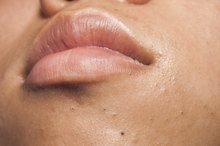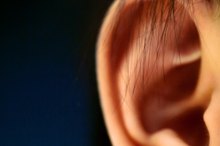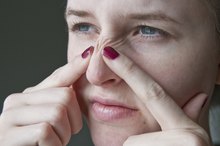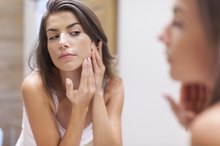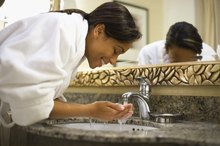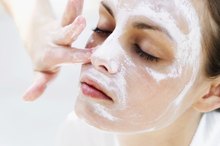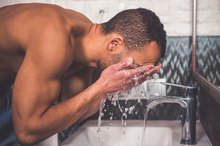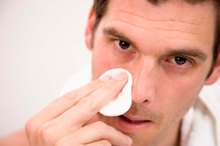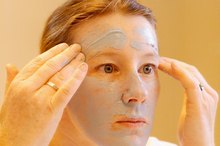Clogged Pores on Nose & Chin
Clogged pores, known clinically as comedones, are an annoying condition for many people, especially teenagers, and can lead to acne. Comedones commonly occur on the nose and chin because the pores in these areas tend to be larger and therefore more easily clogged. Comedones can usually be treated with simple conservative measures at home. However, see a dermatologist if your comedones persist.
Three Types
You may be affected by three types of comedones -- whiteheads; blackheads and microcomedones. A whitehead, or closed comedo, is a clogged pore that does not contain an opening to the surface of the skin. This results in the formation of a white bump under the skin. A blackhead, or open comedo, is a clogged pore that contains an opening to the surface of the skin. When the oil in the pores is exposed to air, the contents of the pore turn black. Microcomedones are very small, undetectable clogged pores.
- You may be affected by three types of comedones -- whiteheads; blackheads and microcomedones.
- A blackhead, or open comedo, is a clogged pore that contains an opening to the surface of the skin.
Why Pores Clog
Oil Bumps on the Face
Learn More
The underlying cause for most clogged pores is the overproduction of oil -- known as sebum -- from your pores. The cells inside pores, known as keratinocytes, become stuck together and form a plug, or comedo. This combination causes bacteria normally found in the pores to flourish and release inflammatory enzymes and chemicals that can lead to pimples. Comedones may be aggravated by skin that is very dry or oily, squeezing, excessive use of moisturizers, humid weather, and certain chemicals and dyes.
- The underlying cause for most clogged pores is the overproduction of oil -- known as sebum -- from your pores.
- Comedones may be aggravated by skin that is very dry or oily, squeezing, excessive use of moisturizers, humid weather, and certain chemicals and dyes.
Take Care of Your Skin
Treat clogged pores with a gentle cleanser, as well as products that help to unclog them. Look for skin care products that are labeled oil-free and “non-comedogenic,” meaning they will not clog pores. Wash your face with a gentle facial cleanser twice a day, as well as after you work out. Avoid harsh facial cleansers, toners, astringents, scrubs, masks or washcloths. These can irritate your skin and cause breakouts. Apply a topical comedolytic product, which acts to unclog pores and also prevent pores from becoming clogged. These include benzoyl peroxide, salicylic acid, glycolic acid, resorcinol and sulfur. Apply a thin layer to your face one to two times daily. Continue to apply these products even if your pores are not clogged as a preventative measure.
- Treat clogged pores with a gentle cleanser, as well as products that help to unclog them.
- Apply a topical comedolytic product, which acts to unclog pores and also prevent pores from becoming clogged.
When to See Your Doctor
Ear Blackheads in Children
Learn More
See your dermatologist if your comedones do not resolve with at-home treatments 1. A doctor may prescribe a stronger comedolytic topical medication, such as a retinoid, and perform more aggressive treatments such as chemical peels, microdermabrasion and comedone extraction.
Hands Off
Whatever treatment you pursue, avoid picking at comedones. Squeezing and picking can cause scarring, which is even harder to treat than clogged pores. Adopt a hands-off approach to your face to keep bacteria and dirt away from your skin.
- Whatever treatment you pursue, avoid picking at comedones.
- Adopt a hands-off approach to your face to keep bacteria and dirt away from your skin.
Related Articles
References
- American Academy of Dermatology: 12 Ways to Get Better Results From Acne Treatment
- American Academy of Dermatology: Physical Procedures for Treating Acne
- Wang S. Understudied skin characteristics awaiting genetic breakthroughs. J Investig Dermatol Symp Proc. 2018;19(2):S101-S102. doi:10.1016/j.jisp.2018.10.005
- American Academy of Dermatology Association. What can treat large pores?
- Draelos ZD. Cosmeceuticals for male skin. Dermatologic Clinics. 2018;36(1):17-20
- Milam EC, Rieder EA. An approach to cosmeceuticals. Journal of Drugs in Dermatology. 2016;15(4):452-6.
- Sakuma TH, Maibach HI. Oily skin: an overview. Skin Pharmacology and Physiology. 2012;25(5):227-35.
- Yeh L, Bonati LM, Silverberg NB. Topical retinoids for acne. Seminars in Cutaneous Medicine and Surgery. 2016;35(2):50-6.
- Zaenglein AL, Pathy AL, Schlosser BJ, et al. Guidelines of care for the management of acne vulgaris. Journal of the American Academy of Dermatology. 2016;74(5):945-73.
Writer Bio
Kimberly Rienecke started her career as a health and fitness writer by working for various websites. She is a certified orthopedic physician assistant and an ACE-certified personal trainer. She also holds a Bachelor of Science in biology from Towson University.
